Physical Address
304 North Cardinal St.
Dorchester Center, MA 02124
We would like to acknowledge and thank Jeffrey Goldsmith, MD, for his significant contributions to prior editions of this chapter.
This chapter divides the discussion of immunohistochemistry (IHC) of the luminal gastrointestinal (GI) tract into three sections: (1) epithelial pathology, (2) neuroendocrine lesions, and (3) spindle cell lesions. We have attempted to compile the innumerable IHC studies that have been applied to these organs into a cogent, useful, and relevant text.
This section includes a brief discussion of antigens/epitopes often used in GI pathology. Table 14.1 shows representative assay conditions for these antibodies. Note that the conditions listed in this table are meant to be guides. All new antibodies must be analytically validated by the laboratory performing the test.
| Antibody | Clone | Dilution | Retrieval |
|---|---|---|---|
| β-Catenin | Polyclonal | 1 : 80 | pH 6.1 |
| BRG1 | EPNCIRIIIA | 1 : 200 | pH 6.1 |
| CDX2 | CDX2-88 | 1:100 | High pH |
| Chromogranin A | 5H7 | RTU | pH 6.1 |
| Cytokeratin 7 | RN7 | RTU | Low pH |
| Cytokeratin 20 | Ks20.8 | RTU | Low pH |
| INI1 | 25 | 1 : 80 | High pH |
| KIT (CD117) | Polyclonal | 1:200 | pH 6.1 |
| MLH1 | MLH1 | 1:10 | Proprietary solution |
| MOC-31 | MOC-31 | 1:40 | Proteinase K |
| MSH2 | FE11 | 1:30 | Proprietary solution |
| MSH6 | 44/MSH6 | 1:800 | pH 9.0 |
| MUC1 | Ma695 | 1:160 | pH 6.1 |
| MUC2 | Ccp58 | 1:100 | pH 6.1 |
| MUC5AC | CLH2 | 1:200 | pH 8.5 |
| MUC6 | CLH5 | 1:800 | pH 6.1 |
| p40 | BC28 | 1 : 50 | pH 6.1 |
| p53 | DO-7 | 1:80 | pH 6.1 |
| p63 | 4A4 | 1:100 | Low pH |
| PMS2 | A16-4 | 1:50 | High pH |
| SATB2 | QT17E11 | 1 : 50 | pH 9.0 |
| Synaptophysin | SNP88 | 1:2560 | pH 6.1 |
| Villin | CWWB1 | 1:200 | Citrate, pH 6.0 |
For the purposes of diagnostic IHC, carcinomas that stain with low- and high-molecular-weight cytokeratins (HMWCKs) include adenocarcinomas of the esophagus and stomach. Those that stain predominantly with low-molecular-weight CK (LMWCK) antibodies include colorectal adenocarcinomas, neuroendocrine tumors, and high-grade neuroendocrine carcinomas (NECs). Carcinomas that stain with predominantly HMWCK antibodies include squamous cell carcinomas (SCCs) of the esophagus and anus.
β-Catenin is an 88-kD member of the catenin family of proteins that are important constituents of the cytoskeleton; β-catenin is important in gene expression and is a component of the Wnt signaling cascade. In certain conditions when the normal degradation of β-catenin is disrupted, this protein accumulates in the cytoplasm and abnormally translocates to the nucleus where it can disrupt normal gene expression ,
Cytokeratin 7 (CK7) is an intermediate filament protein expressed predominantly by ductal epithelial cells of the pancreatobiliary tract, renal collecting ducts, and proximal GI tract. Expression of CK7 is limited to subtypes of adenocarcinomas and SCCs that arise within nonkeratinized mucosa.
In the small intestine, CK20 stains only the highly differentiated small bowel villous enterocytes (CK18 stains the more immature, basilar, proliferative zone cells). In the colon, CK20 stains only the surface epithelial cell layer, and CK20 staining is more extensive and stronger in small bowel neoplasms than in colonic carcinomas.
CDX2 (caudal type homeobox 2) is a homeobox gene that is an integral component of intestinal cell proliferation and differentiation. It appears to function as a tumor suppressor gene in colorectal and some pancreatobiliary and gastric adenocarcinomas.
This protein is an acidic soluble glycoprotein found within neurosecretory granules. , Chromogranin A undergoes posttranslational modification, which varies between GI sites and their associated tumors. Chromogranin is more specific but less sensitive than synaptophysin. Most nonneoplastic neuroendocrine lesions and low-grade NETs diffusely and strongly stain with chromogranin, and this is proportional to the number of intracytoplasmic neurosecretory granules. However, some carcinoids stain weakly with chromogranin, which may reflect differences in the type of amines contained within the tumor cell cytoplasm.
The antibody against this protein stains the transmembrane and cytoplasmic KIT protein, which is a type 3 tyrosine kinase receptor. This antibody is useful for identifying GI stromal tumors (GISTs).
These antibodies are directed at protein components of the mismatch repair (MMR) complex. These proteins function as heterodimers; MLH1 associates with PMS2, and MSH2 associates with MSH6. As such, these pairs of proteins often show pairwise loss of expression. Decreased or absent staining is indicative of quantitative protein deficiencies or mutated protein.
INSM1 (insulinoma-associated protein 1) is a zinc-finger transcription factor that is encoded by the insulinoma-associated-1 (IA-1) gene. It plays a vital role in the development of neuroendocrine differentiation in various tissues and is currently the only nuclear neuroendocrine marker. ,
MOC-31 is one of the myriad monoclonal antibodies against the epithelial adhesion molecule, Ep-CAM. , MOC-31 is expressed in a host of benign epithelia and is expressed in many carcinomas, including those derived from the colon, stomach, breast, pancreas, ovary, and bile ducts. ,
Mucin core polypeptides (MUCs) are the backbone molecule of GI tract mucin and are responsible for the mucus-gel layer, which covers the mucosa. MUC1 (also known as epithelial membrane antigen [EMA]) is normally expressed by enterocytes and intestinal goblet cells, MUC2 is normally secreted by intestinal goblet cells, MUC5AC is expressed by gastric foveolar mucus cells and neoplastic goblet cells, and MUC6 is secreted by gastric antral and fundic gland cells.
Normal p53 protein has an extremely short half-life and is found in small quantities inside cells. As such, scattered, faint p53 positivity can be detected in normal cells by using IHC. Mutations in the TP53 gene often lead to increased nuclear accumulation of an abnormal protein, but in some cases, a truncating mutation can lead to complete loss of the p53 protein (“null” phenotype). Hence, aberrant p53 IHC staining can either be stronger and more diffuse than the normal pattern (“over-expressed”) or can be completely negative.
The TP63 gene is a member of the TP53 gene family; it encodes for several different mRNA isoforms, formed by alternative splicing, that contain (TA) or lack (ΔN) the transactivation domain. The relative concentrations of these protein variants affect the expression and functionality of wild-type p63 and p53 proteins. The p63 protein is expressed in a nuclear pattern in various myoepithelial and is present in the basal layer of squamous epithelium. , The p63 antibody recognizes the TAp63 isoform, while the p40 antibody recognizes the ΔNp63 isoform. p40 has been shown to be equivalent to p63 in sensitivity, but it is markedly superior to p63 in specificity for the diagnosis of pulmonary SCCs.
SATB2 (special AT-rich sequence-binding protein 2) is a 733 amino-acid DNA-binding protein that is involved in transcriptional regulation and chromatin remodeling and plays roles in the nucleoplasm. It is expressed in a tissue-specific manner, with strong nuclear staining restricted to epithelial cells lining the colorectum and appendix, a subset of neurons in the brain, and osteoblast-lineage cells. ,
Both INI1(integrase interactor 1) and BRG1 (brahma-related gene 1) proteins are nuclear proteins responsible for chromatin remodeling and repair and are encoded by SMARC (SWI/SNF related, matrix associated, actin-dependent regulator of chromatin) genes B1 and A4, respectively. Tumors associated with SMARCA deficiency in the gastrointestinal tract are often poorly to undifferentiated high-grade malignancies/carcinomas, which frequently show characteristic morphology such as small to large epithelioid cells, giant cells, and rhabdoid cells, and loss of nuclear staining of SMARC protein(s) by immunohistochemistry.
This protein is a membrane glycoprotein found in the calcium channels of cells. Its expression is independent of chromogranin A.
Villin is a brush border, microfilament-associated, actin-binding protein related to rootlet formation. Staining in colorectal adenocarcinomas is diffusely cytoplasmic with brush border accentuation.
Barrett esophagus (BE) is defined as endoscopically apparent abnormal mucosa extending proximally into the esophagus from the gastroesophageal junction. In the United States, biopsy confirmation of intestinal metaplasia is required, and the most current recommendations require the endoscopically abnormal segment to equal 1 cm or greater in length. , Many studies have demonstrated the reactivity of various markers, including markers of intestinal differentiation such as MUC2 and CDX2 in nongoblet cell columnar epithelium in patients with BE, but no studies have shown these markers to be predictors of the development of goblet cell containing BE. Because goblet cells are often readily identified on the routine hematoxylin and eosin (H&E) stain, the use of IHC to aid the diagnosis of BE is currently not recommended.
Numerous molecular alterations associated with the development of neoplasia within BE have been described. Many of these genetic alterations were used as the foundation for IHC to assist in the morphologic diagnosis and grading of dysplasia. , , Of these altered proteins, p53 is the only antibody with potential utility in the diagnosis of dysplasia. Weak and focal p53 immunoreactivity in BE correlates with a normal (wild-type) TP53 gene status, while either strong, diffuse nuclear positivity or complete absence (“null pattern”) of staining correlates with TP53 gene mutations ( Fig. 14.1 ). In theory, aberrant p53 staining (either increased or lost) as detected by IHC should be a surrogate marker for a TP53 gene mutation and could be used in the diagnosis of dysplasia. However, this is not the case in practice because the correlation between staining and gene abnormalities is not precise and there is a substantial overlap of the patterns of p53 reactivity in epithelia negative for dysplasia, those that show reactive changes, and epithelia with low-grade dysplasia (LGD). Although a recent study indicates that p53 can be used as an ancillary marker of dysplasia in difficult cases, it cannot be used to separate LGD from high-grade dysplasia (HGD). The utility of other markers of dysplasia, such as α-methylacyl-CoA racemase (AMACR) , cyclin D1, , and surface Ki-67, has been reported in the literature, but more studies are needed before they can be applied clinically. Morphology currently remains the gold standard for the diagnosis of BE-associated dysplasia, and ancillary stains are not recommended for diagnosing dysplasia in BE.
There are currently no immunohistochemical markers that can reliably aid in the diagnosis of BE or BE-associated dysplasia.
Although p53 has been shown to be a marker of dysplasia in some reports, additional studies are needed before p53 staining can be used routinely to aid in the diagnosis of BE dysplasia.
Complete negative staining for p53 (with proper controls) is an abnormal pattern of expression and indicates the presence of a TP53 mutation.
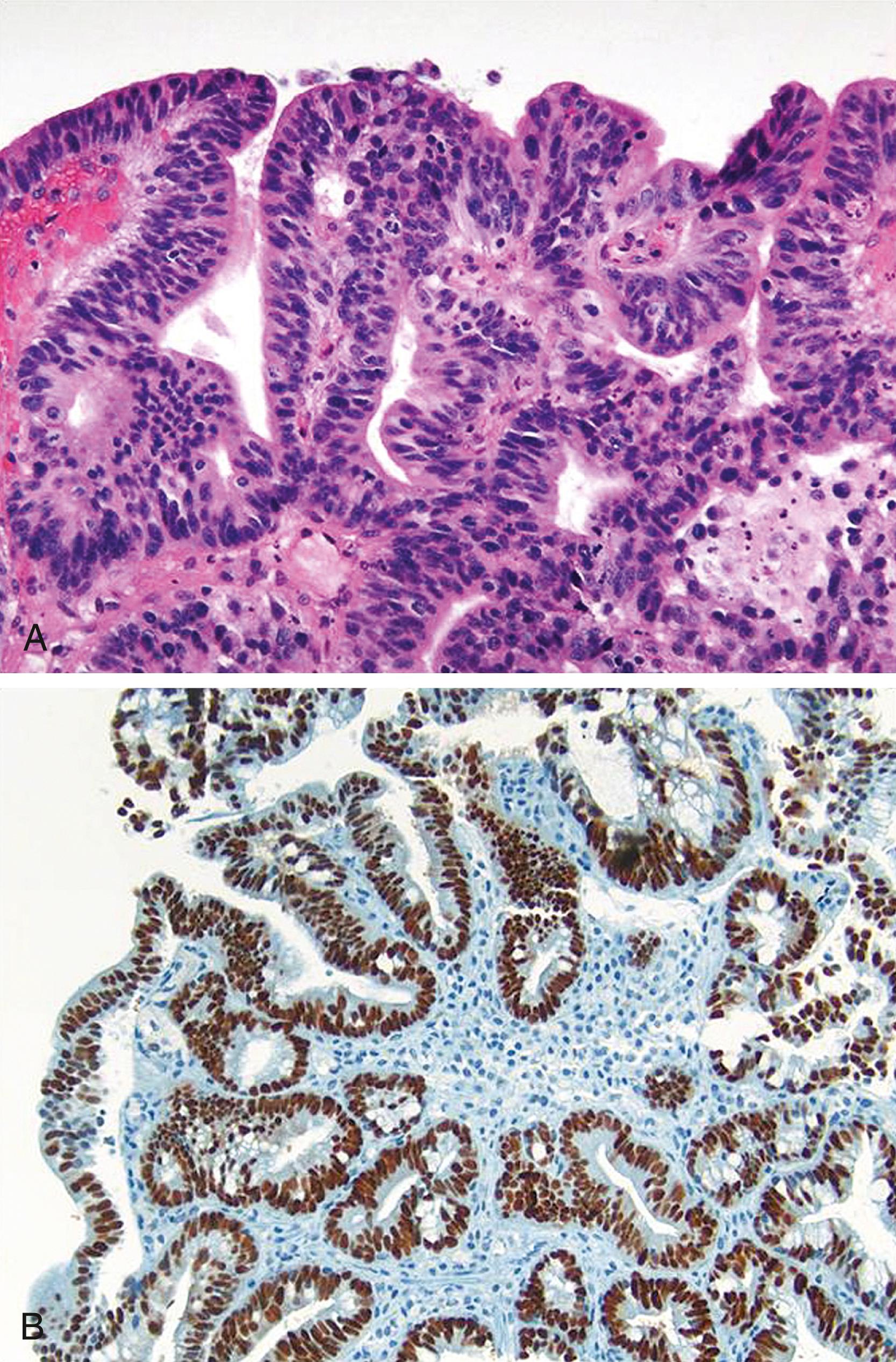
Esophageal adenocarcinomas typically express cytokeratins AE1/AE3, CAM5.2, CK19, and CK7; a minority of cases express CK20. CDX2 expression is variable, and although many tumors may show focal positivity, a significant minority are completely negative, and only a few are uniformly positive. Villin expression is more uniform and is present in approximately 75% of tumors. Most studies have found that esophageal adenocarcinomas are immunophenotypically identical to adenocarcinomas of the gastric cardia (see the following). Some , , but not all studies suggest that esophageal and gastric cardia adenocarcinomas have different CK7/CK20 staining patterns based on statistical comparison of a large number of cases. However, the overlap in staining patterns between the two groups in these studies is substantial, resulting in a limited use of CK7/CK20 staining to differentiate esophageal adenocarcinomas from proximal gastric adenocarcinomas.
Esophageal adenocarcinomas are generally positive for CK7 with none-to-variable expression of CK20 and CDX2.
Esophageal adenocarcinoma is immunophenotypically similar to proximal gastric adenocarcinoma. There is currently no reliable immunohistochemical panel to distinguish these two entities.
SCCs generally stain strongly with medium-molecular-weight and HMWCKs; expression of low-molecular-weight (LMW) keratins is typically weak ( Fig. 14.2 ). Accordingly, most SCCs stain diffusely and strongly with CK antibodies CAM5.2, AE1/AE3, 34βE12, CK5/6, CK14, and CK19. Cytokeratin 34βE12 usually produces stronger and more diffuse staining than CK5/6 ( Fig. 14.3 ).
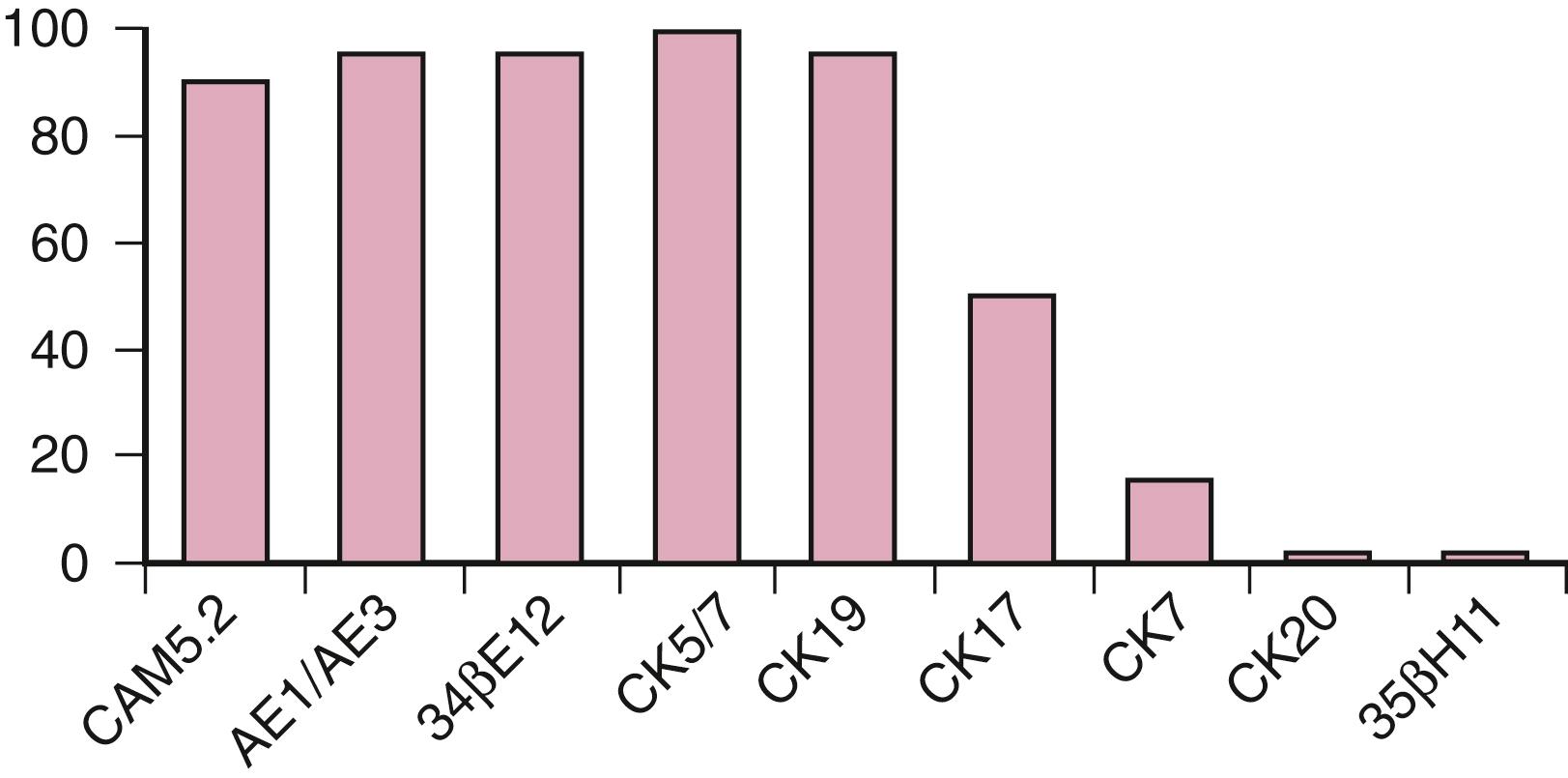
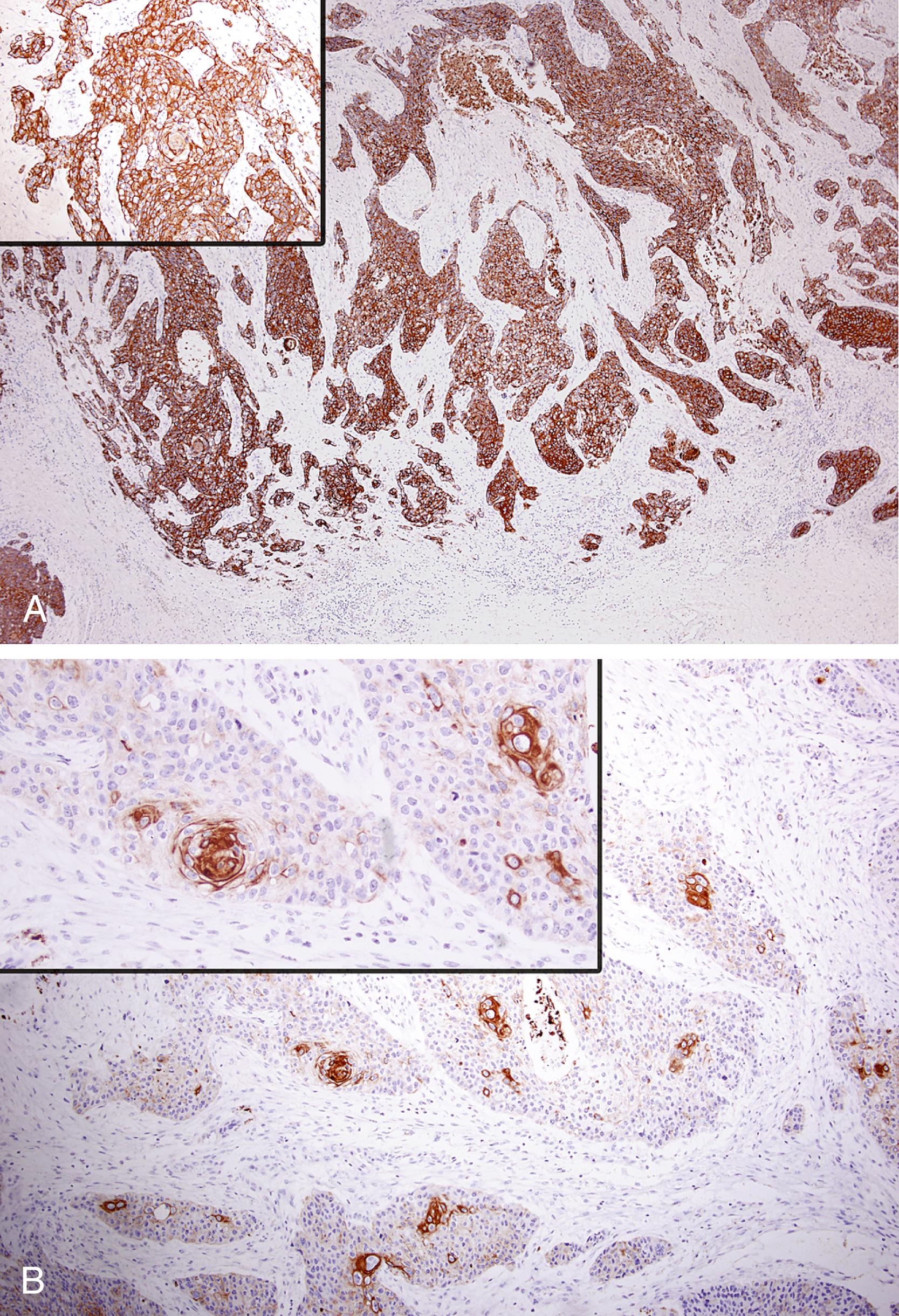
The intensity of CK19 expression increases with higher tumor grade. Approximately 70% of low-grade SCCs stain with CK19 in less than half of the neoplastic cells, whereas almost all high-grade neoplasms are diffusely and strongly reactive. Squamous carcinoma in situ is also positive for CK19, whereas benign squamous mucosa is negative ( Fig. 14.4 ). Other diagnostically useful antibodies that are typically strongly positive are p63 and p40, , thrombomodulin, epithelial membrane antigen (EMA), and selected monoclonal carcinoembryonic antigens (CEAs). ,
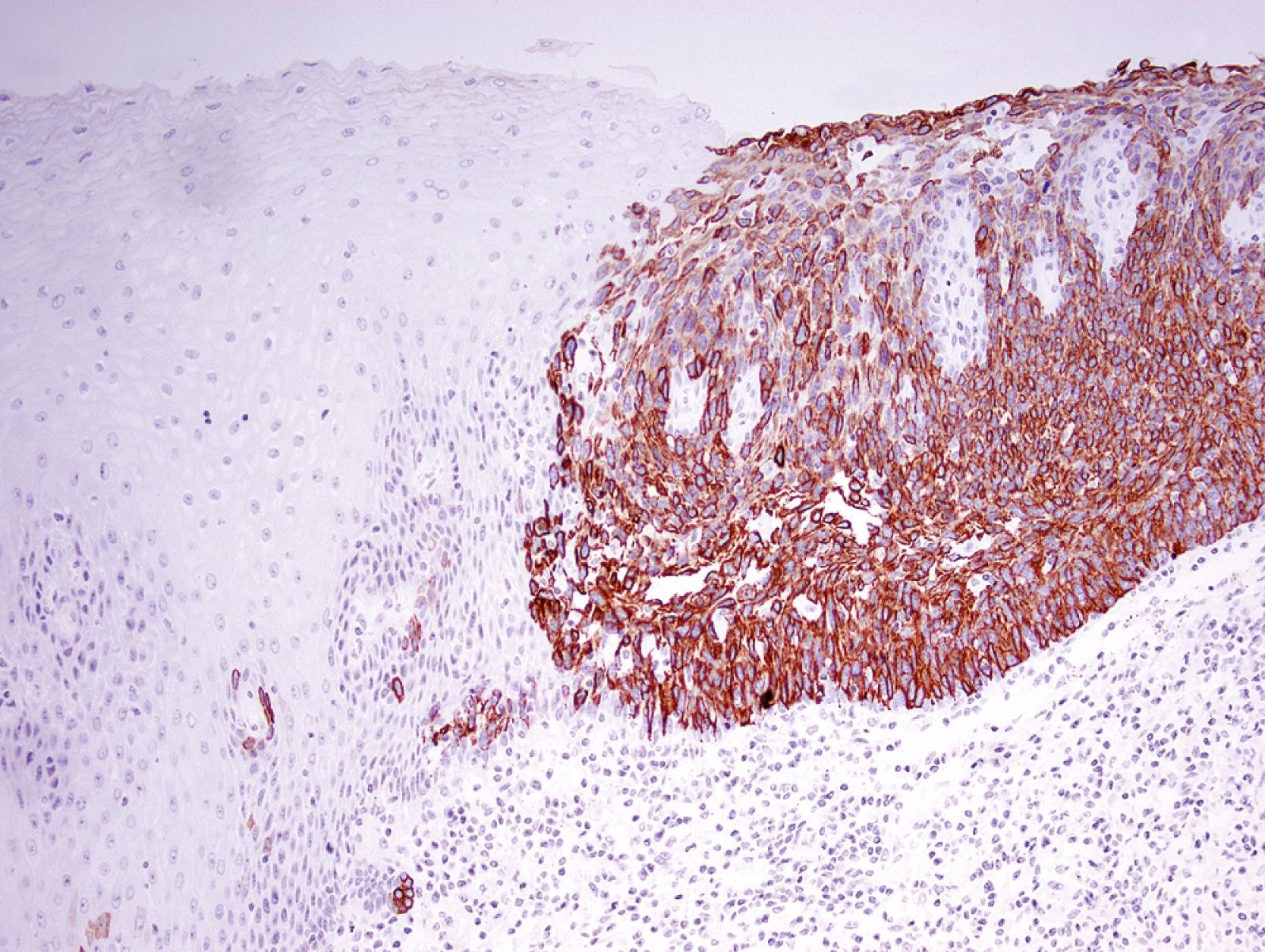
Nonreactive antibodies include CK7, CK20, 35βH11, BerEP4, thyroid transcription factor 1 (TTF-1), and Wilms tumor 1 (WT1). , , , Although CK7 is included in this group, approximately 15% to 30% of SCCs have occasional and scattered clusters of cells that are CK7+. , However, if a positive result is defined as expression in more than 50% of tumor cells, esophageal SCCs are considered CK7−/CK20−.
Primary pulmonary SCC can occasionally be distinguished from esophageal SCC with TTF-1. Although both neoplasms are usually nonreactive, occasional pulmonary SCCs may show extensive and strong nuclear TTF-1 staining, whereas esophageal SCCs are consistently negative for TTF-1.
It is occasionally important to distinguish between poorly differentiated SCC and poorly differentiated adenocarcinoma; p63, p40, and cytokeratins 7, 20, and 5/6 are useful in this context. , SCCs, including poorly differentiated nonkeratinizing neoplasms, are CK7− and CK20− and positive with CK5/6, p63 and p40, whereas adenocarcinomas of the esophagus, stomach, and lung are typically positive with CK7 and CK20 but negative with CK5/6 and p63.
Distinction between SCC and thymic carcinoma is also occasionally required. CD5 can be diffusely and strongly positive in primary thymic carcinoma and may be nonreactive in esophageal SCCs. Importantly, selective CD5 reactivity of thymic carcinomas is highly dependent on the pH of the antigen retrieval solution and the antibody clone. Some CD5 antibodies diffusely and strongly stain both thymic carcinomas and esophageal squamous carcinomas. ,
Mesothelioma can occasionally be morphologically and clinically similar to poorly differentiated, nonkeratinizing, primary esophageal SCC. Both neoplasms are immunoreactive with calretinin and CK5/6, leaving WT1 and p63 as differentiating positive diagnostic markers for mesothelioma. ,
Squamous cell carcinomas (SCCs) stain strongly and diffusely with CAM5.2, AE1/3, CK5/6, p63, and p40.
CK7, CK20, and CEA are either negative or focally positive in poorly differentiated SCCs, whereas these antibodies are strongly positive in poorly differentiated adenocarcinomas.
CD5 testing, if performed correctly, can be used to distinguish thymic carcinoma from esophageal SCC.
A significant minority of SCCs can be focally positive for CK7.
Basaloid squamous cell carcinoma (BSCC) is a morphologic and genetic variant of poorly differentiated SCC. Mixed basaloid/classic SCC or neoplasms of mixed BSCC/adenocarcinoma may be seen. Bcl-2 has been reported to stain BSCC, but it is nonreactive in poorly differentiated, conventional SCC. CK5/6, CK monoclonal-OSCAR, CK13, CK14, CK19, AE1/3, and p63 typically are diffusely and strongly reactive in BSCC, whereas cytokeratins CAM5.2 and 35βH11 are often negative or weakly immunoreactive. Typically, the central cells within each nest are strongly positive for CK5/6 and p63. Moreover, the pseudopalisading, single-cell layer at the periphery of carcinoma nests typically shows myoepithelial differentiation, including reactivity with CK19, S100 protein, and smooth muscle actin (SMA). Similar to some high-grade breast carcinomas, IHC features of myoepithelial cell differentiation can be diffuse.
Most reported esophageal adenoid cystic carcinomas are BSCCs; true adenoid cystic carcinomas of the esophagus are extremely rare. Esophageal salivary gland-type adenoid cystic carcinomas stain diffusely and strongly with CAM5.2 and AE1/AE3. In addition, 34βE12 and CEA stain the ductal-type cells, whereas S100, actin, and vimentin stain the basaloid-type cells.
BSCCs with a solid growth pattern, those with a cribriform growth pattern that mimics adenoid cystic carcinoma, salivary gland-type adenoid cystic carcinomas, and high-grade NECs are often morphologically similar and may be difficult to separate, especially in small biopsy fragments. IHC is useful in this context ( Fig. 14.5 ). CK5/6, CK7, 34βE12, CK19, p63, CEA, chromogranin, and synaptophysin are useful for distinguishing among these three entities. , CK7 is often the single positive marker in high-grade NEC. Care should be given to avoid misinterpreting the nonspecific synaptophysin staining of necrotic debris found in BSCCs as true cytoplasmic granular immunoreactivity.
Central areas or nests of BSCC are CK5/6 and p63 positive, whereas the peripheral rim of palisading cells may be CK19 positive.
Most adenoid cystic-like carcinomas are BSCCs. True adenoid cystic carcinomas of the esophagus are extremely rare.
High-grade (small cell) NECs is diffusely synaptophysin and CK7 positive.
Nonspecific synaptophysin staining can be present in BSCCs and should not be interpreted as true cytoplasmic granular positivity.
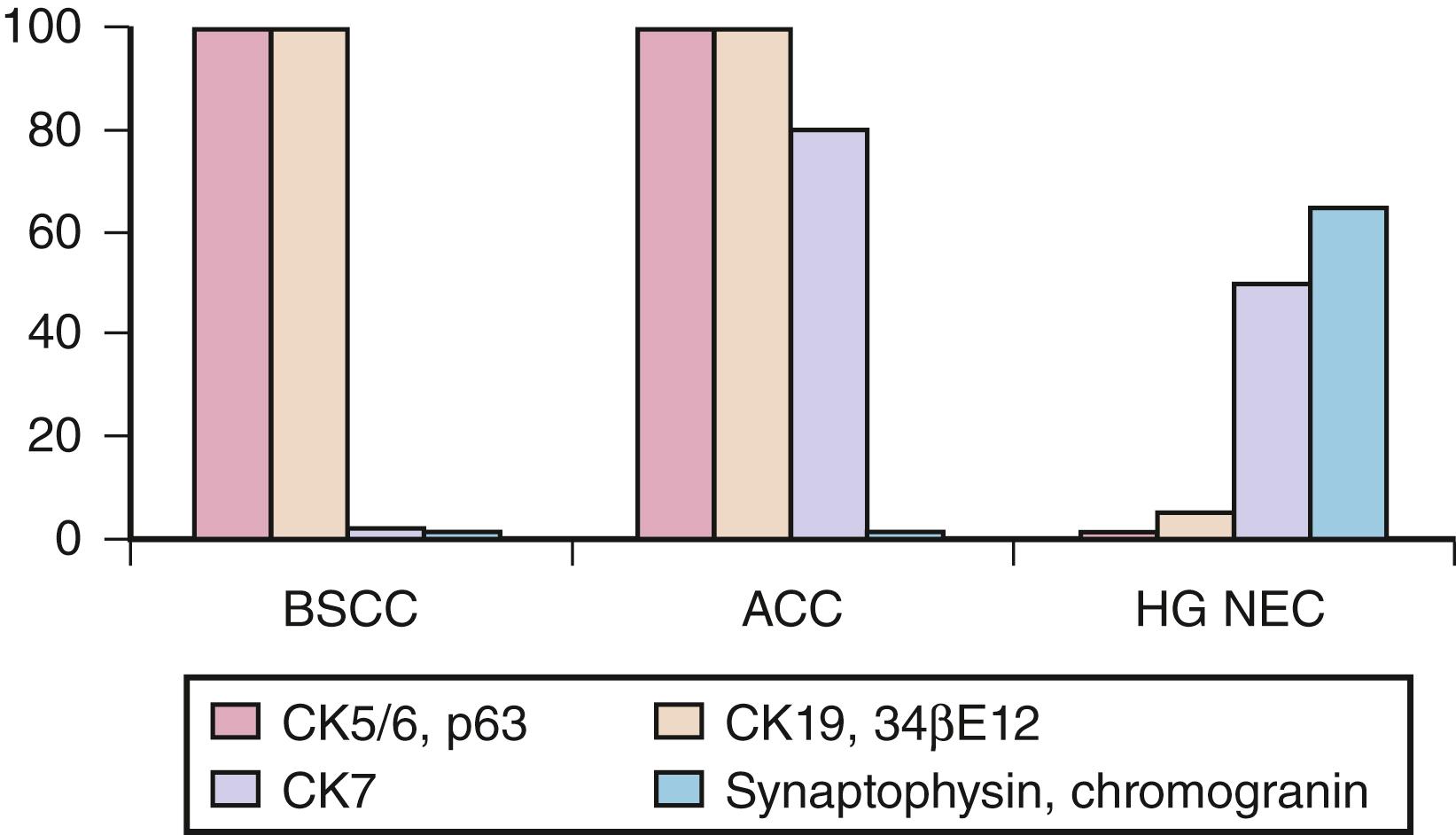
Esophageal carcinomas can rarely show spindle cell or mesenchymal differentiation; however, the spindle cell component is often associated with recognizable epithelial differentiation. Not surprisingly, this mesenchymal differentiation shows decreased cytokeratin expression. The cytokeratin clones OSCAR and CK5/6 produce the strongest and most diffuse immunoreactivity. CK OSCAR is the preferred antibody for distinguishing neoplastic spindle cells from reactive myofibroblasts; CAM5.2, 35βH11, and AE1/AE3 may give variable results. Among these three antibodies, AE1/ AE3 produces the strongest and most diffuse staining. Neoplastic spindle cells can stain with actin antibodies; however, desmin is usually negative, providing the IHC distinction from leiomyosarcoma. True spindle cell rhabdomyosarcomatous differentiation can also occur, in which the cells stain with pan–muscle actin, desmin, and other markers of rhabdomyoblastic differentiation. ,
Lymphocytic gastritis is usually a manifestation of celiac disease and, occasionally, of Helicobacter pylori infection. In patients with celiac disease, the density of surface intraepithelial lymphocytes (IELs) is usually lower than that seen in the duodenum. Gastric IELs are T lymphocytes that stain with CD45RO, CD3, CD7, CD8, and T-cell–restricted intracellular antigen 1 (TIA-1). ,
Proton-pump inhibitor and H. pylori eradication medications decrease the density of H. pylori organisms and alter their shape from spiral to coccoid. Coccoid-shaped H. pylori can be difficult to distinguish from small mucin globules or extracellular debris on modified Giemsa or other histochemical stains. IHC is a more reliable and sensitive method for detecting H. pylori , especially when the organisms are few in number, or when they are coccoid in shape ( Fig. 14.6 ). Helicobacter IHC is not indicated in the context of a histologically normal biopsy unless that patient has a previous diagnosis of H. pylori gastritis. Additionally, some H. pylori antibodies cross-react with H. heilmannii , which can occasionally be useful when the morphology of these organisms does not unequivocally allow for their identification on routine stains.
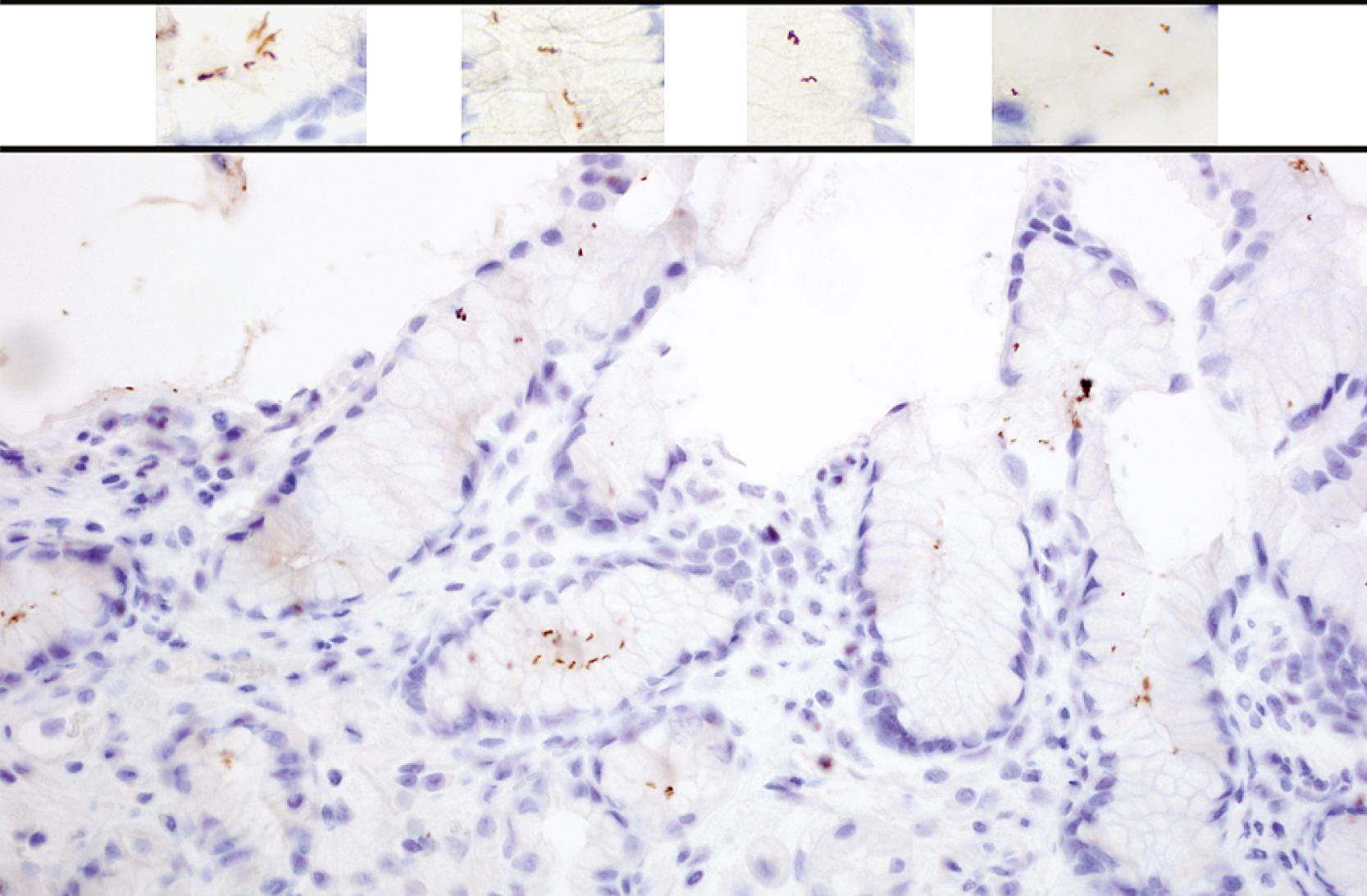
IHC can be a useful adjunct in the diagnosis of autoimmune gastritis (AIG), and most cases of which show hyperplasia of the enterochromaffin-like (ECL) cell compartment secondary to hypergastrinemia. This phenomenon can be highlighted using synaptophysin and/or chromogranin IHC. Normal mucosa shows occasional synaptophysin- and/or chromogranin-positive cells within the epithelial compartment. Synaptophysin also nonspecifically stains the zymogen granules of the chief cells, resulting in an increased background while chromogranin exclusively highlights endocrine cells. In AIG, intraepithelial linear arrays and/or extraepithelial nodules of synaptophysin- or chromogranin-positive ECL cells may be seen ( Fig. 14.7 ).

In addition to the detection of ECL hyperplasia, IHC for gastrin can be helpful in separating atrophic “antralized” oxyntic mucosa, with complete loss of both parietal and chief cells, from true antral mucosa. In fully developed AIG, these two types of mucosa can be difficult to separate on routine histology. Gastrin-staining cells are present in the antrum and are absent in atrophic oxyntic mucosa. Of note, when assessing gastric biopsies for the presence of body-predominant atrophic gastritis, three stains—synaptophysin, chromogranin, and gastrin—must be assessed in areas free of intestinal metaplasia, because the intestinal metaplasia contains its own neuroendocrine cells that may be gastrin positive (see Fig. 14.7 ).
Fundic gland polyps occur as sporadic lesions and may be associated with long-term proton-pump inhibitor therapy. In addition, fundic gland polyps may arise in association with familial adenomatous polyposis (FAP) and Zollinger-Ellison syndromes. Morphologic distinctions between the sporadic and syndromic polyps can be subtle. CK7 has been reported to stain sporadic polyps and Zollinger-Ellison syndrome–associated polyps, whereas β-catenin expression has been described in sporadic polyps but not in FAP-associated polyps. IHC is not routinely used to evaluate fundic gland polyps.
T-cell markers can be used to highlight IELs in suspected cases of lymphocytic gastritis associated with celiac disease or H. pylori infection.
IHC staining for H. pylori is useful when treatment-associated changes reduce the number of organisms or alter their normal appearance.
In cases of suspected AIG, gastrin IHC can be used to distinguish antral from atrophic body or fundic (oxyntic) mucosa; synaptophysin and chromogranin IHC are useful in the detection of enterochromaffin-like cell hyperplasia, a characteristic feature of AIG.
Synaptophysin, chromogranin, and/or gastrin positive neuroendocrine cells can be present in foci of intestinal metaplasia, so these foci should not be assessed when interpreting these stains.
Gastric cancer can be classified by anatomic location, histologic features, and, more recently, molecular mechanisms. Anatomically, gastric cancers can be divided into two clinically and epidemiologically distinct subtypes: proximal (cardia, gastroesophageal) and distal (non-cardia, true gastric) adenocarcinomas. Histologically, gastric adenocarcinomas have generally been classified into intestinal and diffuse (poorly cohesive/signet-ring cell) types. Although it is important for pathologists to characterize gastric adenocarcinomas into one of these two main morphologic subtypes, the IHC staining pattern of these two subtypes is similar. As a result, both types are discussed together in this section. Gastric adenocarcinomas stain with various CKs ( Fig. 14.8 ). The reactivity of several other antibodies is listed in Table 14.2 , and some of which are discussed in more detail.
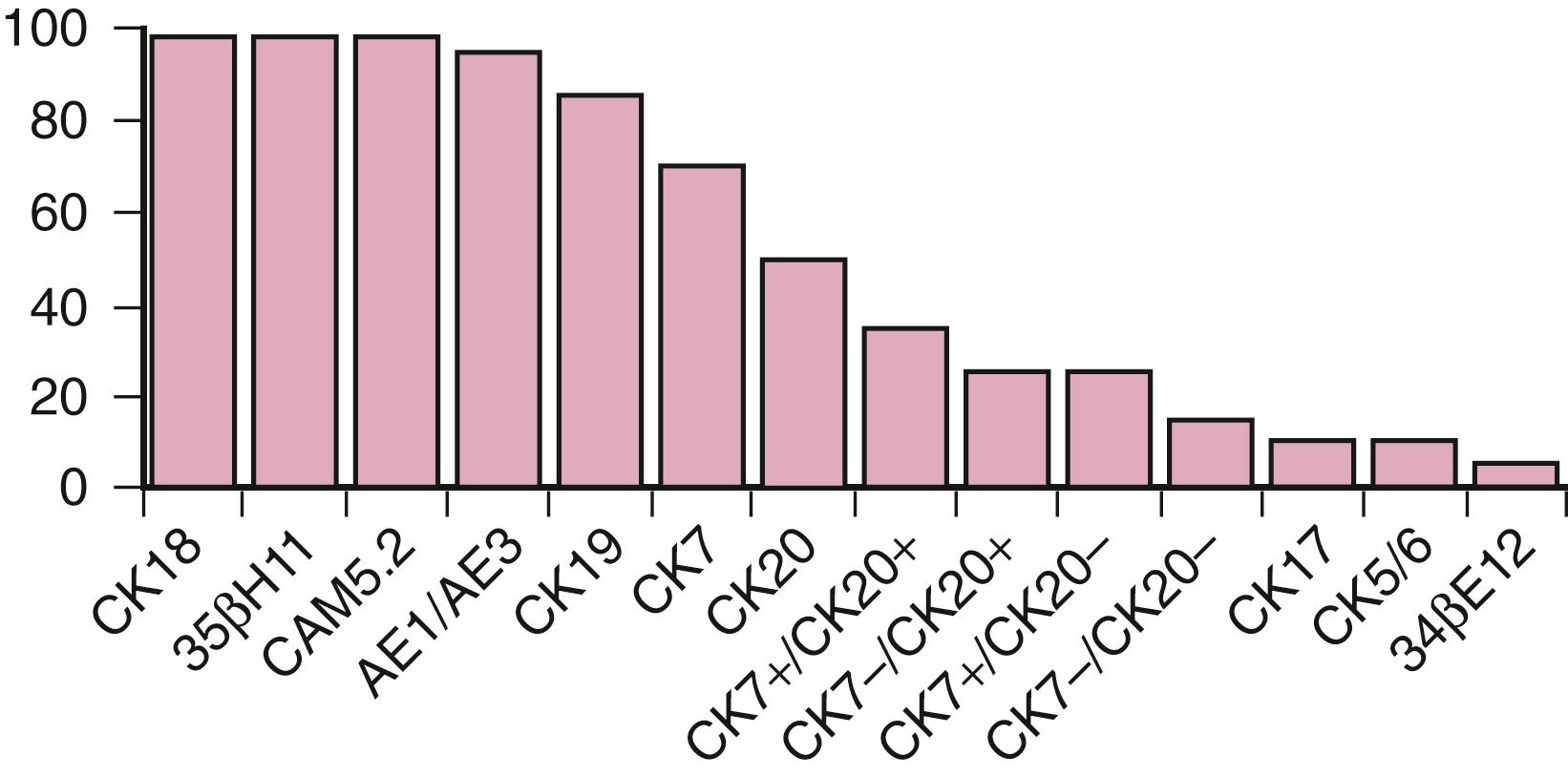
| Antibody | Reactivity | Comments |
|---|---|---|
| AMACR (p504s) | + | AMACR more commonly expressed in intestinal-type and high-grade dysplasia |
| CA-125 | R | Single cells or small foci evident |
| CA19-9 | S | — |
| CDX2 | S | Heterogeneous and variable staining seen in 20%–90% of cases |
| CEA | + | Monoclonal antibody more discriminatory |
| GCDFP-15 | − | Rare (<1%) signet-ring cells can be positive |
| HepPar1 | R | Positive in hepatoid type of alpha-fetoprotein producing gastric carcinomas |
| MUC1 | R | — |
| MUC2 | S | Up to 50% of cases can be positive |
| MUC4 | S | — |
| MUC5AC | S | 38%–70% of cases can be positive |
| MUC6 | S | 30%–40% of cases can be positive |
| TTF-1 | − | — |
| Villin | S | — |
| Vimentin | R | Positive staining seen in spindle cell (sarcomatoid) carcinomas |
Gastric adenocarcinomas are diffusely and strongly positive for AE1/AE3 and 35βH11. Cytokeratin CAM5.2 produces diffuse strong staining in approximately two-thirds of these neoplasms and produces weak to moderate, patchy staining in the other third. CKs 18 and 19 are diffusely and strongly positive. ,
CK7 expression is an important marker of committed gastric epithelial cells and gastric adenocarcinoma. Approximately 50% of gastric adenocarcinomas are strongly positive in a diffuse or patchy distribution; 30% have rare clusters of strongly reactive cells, and 20% are weakly positive or are negative ( Fig. 14.9 ).
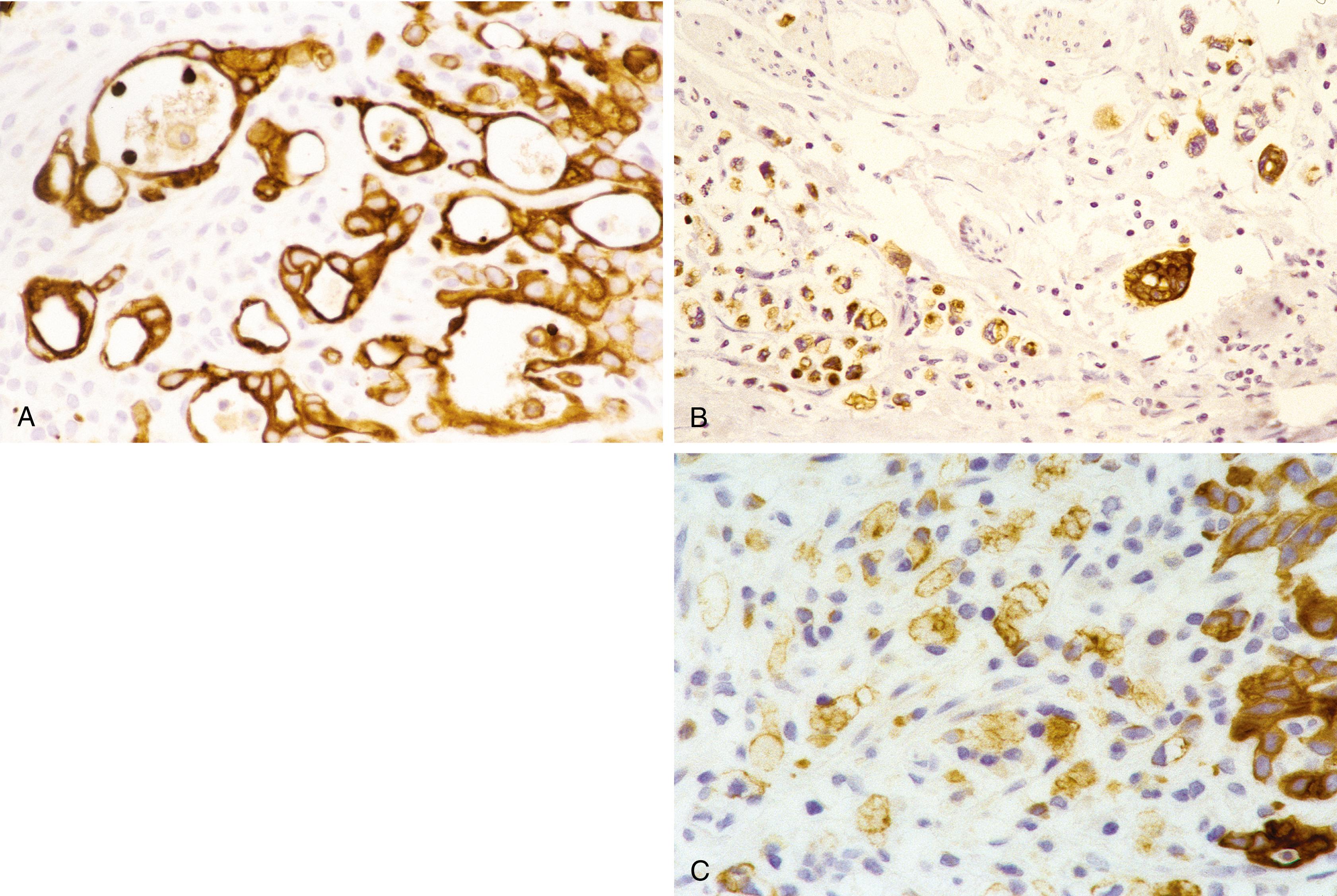
Approximately 40% of gastric adenocarcinomas are strongly positive for CK20 in a patchy or diffuse distribution, 20% are weakly positive in a patchy distribution, and 40% are negative ( Fig. 14.10 ). , ,

Become a Clinical Tree membership for Full access and enjoy Unlimited articles
If you are a member. Log in here